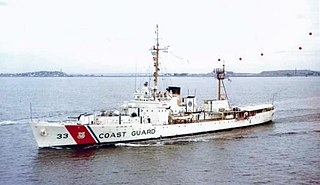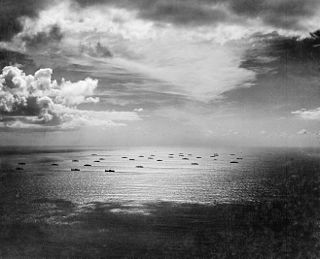
The HX convoys were a series of North Atlantic convoys which ran during the Battle of the Atlantic in the Second World War. They were east-bound convoys and originated in Halifax, Nova Scotia from where they sailed to ports in the United Kingdom. They absorbed the BHX convoys from Bermuda en route. Later, after the United States entered the war, HX convoys began at New York.

This is a timeline for the Battle of the Atlantic (1939–1945) in World War II.

The Treasury-class cutter was a group of seven high endurance cutters launched by the United States Coast Guard between 1936 and 1937. The class were called the "Treasury class" because they were each named for former Secretaries of the Treasury. These ships were also collectively known as the "327's" as they were all 327 feet (100 m) in length. The Treasury-class cutters proved versatile and long-lived warships. Most served the United States for over 40 years, including with distinction through World War II, Korea, and Vietnam.
The SC convoys were a series of North Atlantic convoys that ran during the battle of the Atlantic during World War II.

Convoy ON 166 was the 166th of the numbered ON series of merchant ship convoys Outbound from the British Isles to North America. Sixty-three ships departed Liverpool 11 February 1943 and were met the following day by Mid-Ocean Escort Force Group A-3 consisting of the Treasury-class cutters Campbell and Spencer and the Flower-class corvettes Dianthus, Chilliwack, Rosthern, Trillium and Dauphin.

Convoy SC 121 was the 121st of the numbered series of World War II Slow Convoys of merchant ships from Sydney, Cape Breton Island to Liverpool. The ships departed New York City 23 February 1943; and were met by the Mid-Ocean Escort Force Group A-3 consisting of the United States Coast Guard (USCG) Treasury-class cutter USCGC Spencer, the American Wickes-class destroyer USS Greer, the British and Canadian Flower-class corvettes HMS Dianthus, HMCS Rosthern, HMCS Trillium and HMCS Dauphin and the convoy rescue ship Melrose Abbey. Three of the escorts had defective sonar and three had unserviceable radar.

Convoy SC 118 was the 118th of the numbered series of World War II slow convoys of merchant ships from Sydney, Cape Breton Island, to Liverpool. The ships departed New York City on 24 January 1943 and were met by Mid-Ocean Escort Force Group B-2 consisting of V-class destroyers Vanessa and Vimy, the Treasury-class cutter Bibb, the Town-class destroyer Beverley, Flower-class corvettes Campanula, Mignonette, Abelia and Lobelia, and the convoy rescue ship Toward.

Convoy SC 94 was the 94th of the numbered series of World War II Slow Convoys of merchant ships from Sydney, Cape Breton Island, Nova Scotia, to Liverpool. The ships departed Sydney on 31 July 1942 and were met by Mid-Ocean Escort Force Group C-1.
Convoy SC 42 was the 42nd of the numbered series of World War II Slow Convoys of merchant ships from Sydney, Cape Breton Island to Liverpool. SC 42 was attacked over a three night period in September 1941, losing 16 ships sunk and 4 damaged. This was the worst Allied loss following the attack on convoy SC 7 the previous year. Two attacking U-boats were destroyed.

Mid-Ocean Escort Force (MOEF) referred to the organisation of anti-submarine escorts for World War II trade convoys between Canada and Newfoundland, and the British Isles. The allocation of United States, British, and Canadian escorts to these convoys reflected preferences of the United States upon their declaration of war, and the organisation persisted through the winter of 1942–43 despite withdrawal of United States ships from the escort groups. By the summer of 1943, United States Atlantic escorts were focused on the faster CU convoys and the UG convoys between Chesapeake Bay and the Mediterranean Sea; and only British and Canadian escorts remained on the HX, SC and ON convoys.

Western Local Escort Force (WLEF) referred to the organization of anti-submarine escorts for World War II trade convoys from North American port cities to the Western Ocean Meeting Point near Newfoundland where ships of the Mid-Ocean Escort Force (MOEF) assumed responsibility for safely delivering the convoys to the British Isles.

The UG convoys were a series of east-bound trans-Atlantic convoys from the United States to Gibraltar carrying food, ammunition, and military hardware to the United States Army in North Africa and southern Europe during World War II. These convoys assembled in Hampton Roads near the mouth of Chesapeake Bay and terminated in various North African locations as Axis forces retreated from 1942 through 1945.

The CU convoys were a World War II series of fast trans-Atlantic convoys to the British Isles. The earliest convoys of the series were tankers sailing directly from petroleum refineries at Curaçao to the United Kingdom. Most convoys of the series assembled in New York City and included fast freighters and troopships, with tankers arriving from Aruba via TAG convoys to Guantánamo Bay and GN convoys from Guantánamo to New York.
Convoy HX 300 was the 300th of the numbered series of World War II HX convoys of merchant ships from Halifax to Liverpool. It started its journey on 17 July 1944 and was the largest convoy of the war, comprising 166 ships.

Convoy HX 212 was the 212th of the numbered series of World War II HX convoys of merchant ships from HalifaX to Liverpool. The ships departed New York City on 18 October 1942 and were met on 23 October by Mid-Ocean Escort Force Group A-3 consisting of the United States Coast Guard Treasury-class cutter USCGC Campbell, the destroyer Badger and the Flower-class corvettes Dianthus, Rosthern, Trillium, Dauphin, Alberni, Summerside and Ville de Quebec. The first five escorts had worked together previously, but the last three corvettes were attached to the convoy only for passage to the eastern Atlantic in preparation for assignments on Operation Torch. Summerside was the only escort equipped with modern Type 271 centimeter-wavelength radar.

Convoy ON 144 was a trade convoy of merchant ships during the Second World War. It was the 144th of the numbered series of ON convoys Outbound from the British Isles to North America. The ships departed Liverpool on 7 November 1942 and were joined on 8 November by Mid-Ocean Escort Force Group B-6 consisting of the Flower-class corvettes Vervain, Potentilla, Eglantine, Montbretia and Rose and the convoy rescue ship Perth. Group B-6 had sailed without the destroyers Fame and Viscount which had been damaged in the battle for eastbound convoy SC 104. The United States Coast Guard cutters Bibb, Duane, and Ingham accompanied the convoy from the Western Approaches with ships that detached for Iceland on 15 November.
Convoy HX 126 was the 126th of the numbered series of World War II HX convoys of merchant ships from HalifaX to Liverpool.
Convoy Battles of World War II occurred when convoys of cargo ships assembled for mutual defense, and were attacked by enemy submarines, surface ships, and/or aircraft. Most were in the North Atlantic from 1939 to 1943, and involved attacks by U-boat wolfpacks. Convoy battles also occurred in the Arctic Ocean, Mediterranean Sea and western Pacific Ocean.
Convoy HG 53 was the 53rd of the numbered series of World War II HG convoys of Homeward bound merchant ships from Gibraltar to Liverpool. Convoy HG 53 lost nine ships during a coordinated attack in February 1941. HG 53 was one of the few Atlantic convoys to have ships sunk by submarines, by aircraft, and by surface ships.











